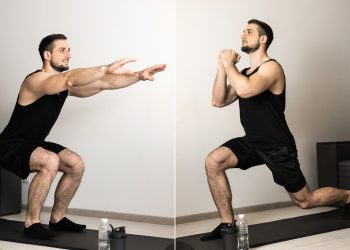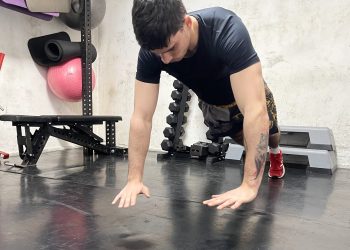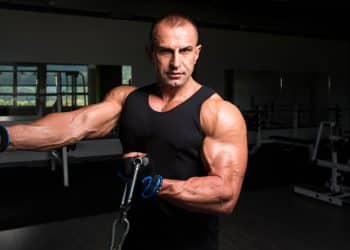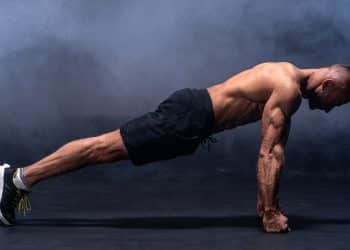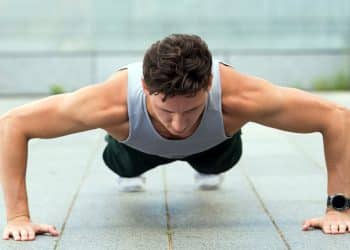While we can’t prove it, push-ups are probably the most widely performed exercise in the world today. School kids to soldiers to elite athletes do push-ups as part of their training. The humble push-up is both convenient and effective, which is why it’s such a popular workout choice.
Push-ups are primarily a chest and triceps exercise and, when you do them, you have to support and lift about 60% of your body weight. You can make them easier by bending your legs and resting on your knees – a move often called the three-quarter push-up.
But, if you want a more challenging workout, you can raise your feet to put more weight in your hands; the higher your feet, the harder the exercise becomes.
If you REALLY want to test your push-up strength, you can raise your feet all the way up so your body is vertical – a handstand push-up. Handstand push-ups are a ninja-level exercise. However, being completely upside-down changes the agonist (target muscle) of the movement.
In this article, we reveal why and how to do handstand push-ups and provide you with a few tips and variations, too.
- Target Muscle Group: Triceps brachii, deltoids
- Type: Hypertrophy, strength
- Mechanics: Compound
- Equipment: None/bodyweight
- Difficulty: Advanced
Muscles Worked
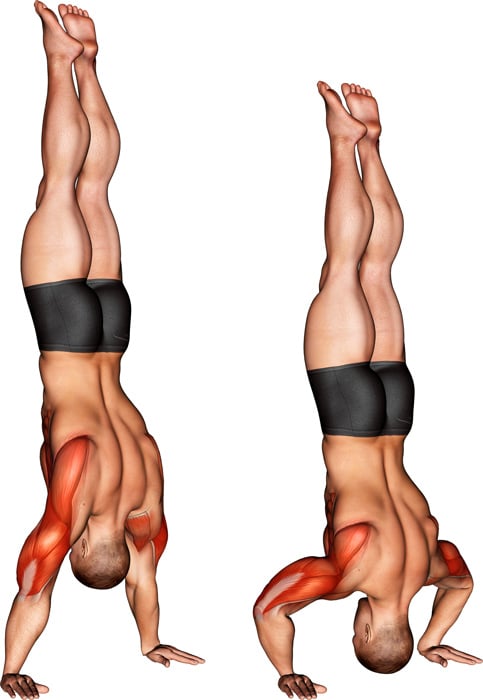
Handstand push-ups are a compound exercise, which means there are several muscles and joints working together. The main muscles involved in handstand push-ups are:
Deltoids – known as the delts for short, these are your primary shoulder muscles. There are three deltoid muscles or heads: anterior (front), medial (middle), and posterior (rear). All three heads are involved in handstand push-ups, but the anterior deltoid is the most active.
Triceps brachii – located on the back of your upper arm, your triceps brachii is responsible for shoulder extension. The triceps are heavily involved in handstand push-ups in a synergistic or helper role.
Upper trapezius – the traps are a large diamond-shaped upper back muscle. There are three sets of fibers, each of which has a different function. The lower traps depress your shoulder girdle, the middle traps retract the shoulder girdle, and the upper traps elevate your shoulder girdle. All three sets of fibers are active during handstand push-ups, but the upper traps have the most work to do.
Core – the collective term for the muscles that encircle your midsection, your core stabilizes your spine so that your body remains rigid and straight during your workout. If your legs wobble during handstand push-ups, you may find yourself leaning to one side and losing your balance.
How To Perform Handstand Push-Ups
Handstand push-ups are a challenging calisthenic or bodyweight exercise. Gymnasts make this exercise look easy, but most exercisers will find doing even one rep quite tricky. The heavier you are, the harder this exercise becomes. Follow these steps to increase your chances of doing this exercise while reducing your risk of injury.
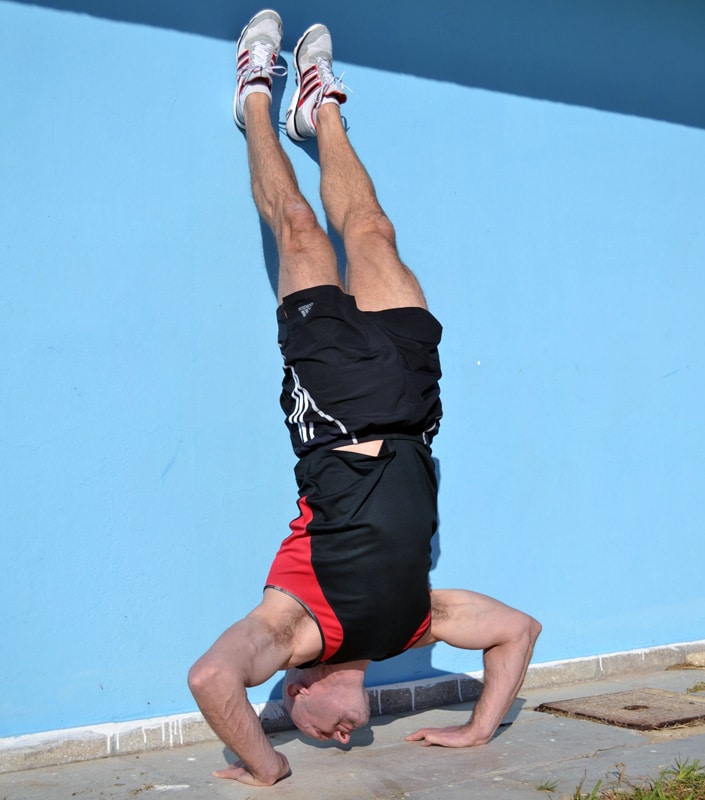
- Take off your shoes; the last thing you want is to make this exercise harder by wearing shoes that create extra friction against the wall.
- Find a smooth wall to do your push-ups against. Make sure there are no pictures or other obstructions.
- Squat down and place your hands flat on the floor, about shoulder-width apart. Your fingers should be pointing forward. Put a cushion between your hands for safety if you think you need one. Your hands should be about 12 inches away from the wall.
- Starting with one foot forward and one foot back, kick up and into a handstand, so your feet are resting against the wall. Brace your core and get your balance. Keep your legs straight.
- When you feel stable, bend your arms and lower your head down to lightly touch the floor.
- Extend your arms and push yourself back up.
- On completion, lower your legs back to the floor and stand up. Take a moment to check your balance; it’s not uncommon to feel a little dizzy after doing this exercise.
Handstand Push-Up Benefits
Handstand push-ups are far from easy, so you may be wondering if they’re worth learning and adding to your workouts. Here are the main benefits of handstand push-ups:
Improved balance and agility – handstand push-ups have their origin in gymnastics. They don’t just make you stronger; they’re also good for things like balance, coordination, and agility. If you want to move better, maybe for sports, handstand push-ups can help.
Equipment-free shoulder workout – no barbell or dumbbells? No problem! Build shoulders like boulders with handstand push-ups. Not convinced? Check out the shoulder development of elite gymnasts. A lot of them put many bodybuilders to shame.
A useful test of relative strength – relative strength is your strength compared to your body weight. While your 1RM bench press might win you gym bragging rights, relative strength is usually more important for sports. Losing weight often makes bodyweight exercises easier, leading to better performance.
Easy to regress and progress – there are lots of handstand push-up variations to try, some of which are easier, while others are considerably harder. This is an exercise you can adapt according to your current strength.
An impressive feat of strength – like pull-ups, doing your first handstand push-up is a significant fitness benchmark. Not many exercisers can do them, so you can feel a real sense of accomplishment when you pump out your inaugural rep.
Variations and Alternatives
While there are plenty of reasons to add handstand push-ups to your workouts, there will also be times when they may not be practical or possible. Alternatively, you may need ways to make this exercise easier or harder. Whatever you want, we’ve got plenty of handstand push-up variations and alternatives to try.
1. Pike push-ups
Pike push-ups work the same muscles as handstand push-ups but put a lot less weight on your arms. If you aren’t strong enough to do handstand push-ups yet, this exercise is the next best thing. Build your pressing strength with pike push-ups, and you’ll soon be able to do the fully inverted version.
How to do it:
- Adopt the push-up position with your arms and body straight, hands about shoulder-width apart.
- Lift your hips into the air and walk your hands in toward your hands, so your body resembles an inverted V. Brace your abs and pull your shoulders down and back.
- Bend your arms and lower your head to the floor.
- Push yourself back up and repeat.
- Make this exercise harder by placing your feet on a raised surface, such as an exercise bench.
2. Parallette Handstand Pushup
When you do handstand push-ups, your range of motion is limited by the floor. Raising your hands on handles called parallettes means you can work through a larger range of motion, making the exercise harder. No parallettes? No problem! You can use regular push-up handles, a couple of stacked yoga blocks, some bricks, or even a couple of hefty books.
The higher you raise your hands, the harder your workout will be. However, you should take care not to hyperextend your shoulders by descending too far.
3. Handstand holds
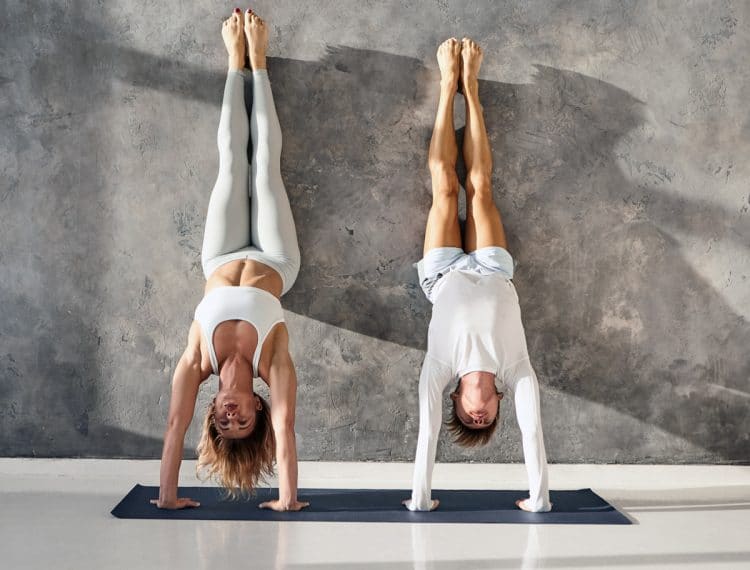
Simply kicking up into and holding a handstand will give your shoulders a good workout, albeit an isometric or static one. If you’ve never done handstand push-ups, start with handstand holds. This will teach you how to get up into the correct starting position and get you familiar with being upside down.
4. Wall walks
If you aren’t quite ready for handstand push-ups but still want a demanding shoulder workout, this could be the exercise for you. Working your deltoids, triceps, and core, this move will develop the stability and strength you need to do full-handstand push-ups. It’s also a killer core workout.
How to do it:
- Adopt the push-up position with your arms straight and your feet against a flat wall. Brace your abs.
- Walk your hands back and your feet up the wall until you are in a handstand position.
- Walk your hands forward and feet down until you are back in the push-up position with your feet against the wall.
- Stop here or, if you are feeling strong, repeat.
5. Handstand Push-up Negative
You are stronger eccentrically than you are concentrically. This means you can lower more weight than you can lift. Make the most of this phenomenon to build the strength necessary to do full handstand push-ups. A few weeks of eccentric training should lead to your first complete rep.
How to do it:
- Place your hands flat on the floor, about shoulder-width apart. Your fingers should be pointing forward. Put a cushion between your hands for safety if you think you need one. Your hands should be about 12 inches away from the wall.
- Starting with one foot forward and one foot back, kick up and into a handstand, so your feet are resting against the wall. Brace your core and get your balance.
- When you feel stable, bend your arms and slowly lower your head down to lightly touch the floor.
- Lower your legs to the floor, kick back up into the handstand position and repeat.
- End your set when you are no longer able to control your descent.
6. Assisted handstand push-ups
Lifting your entire body weight with just your arms is quite a challenge. Take some of the load off your arms by asking for your training partner to lift your legs.
Alternatively, as demonstrated in this video, you can also use a resistance band. Start off with strong assistance and then gradually wean yourself off it until you are strong enough to do handstand push-ups unaided.
7. Wall facing handstand push-ups
Some people prefer to do their handstand push-ups facing the wall. It’s somewhat easier to balance in this position, which may help instill more confidence. If you are struggling with regular handstand push-ups, try this variation.
However, getting into position is not as easy, and you’ll need to do a wall walk (exercise #4) to do this variation.
8. Freestanding handstand push-ups
If you have the strength to do handstand push-ups against a wall, and you can hold an unsupported handstand without losing your balance, you may be ready to try unsupported handstand push-ups.
It’s beyond the scope of this article to teach you how to do an unsupported handstand, as it’s a complex gymnastic skill. But, if you are strong and have outstanding balance, you may be able to rise to the challenge.
Needless to say, if you CAN’T hold a stable handstand, you should not attempt this variation.
Handstand Push-up Tips
Get more from your handstand push-up workouts with these handy tips!
Grease the groove – handstand push-ups are a much about skill as they are strength. Get better sooner by using the grease the groove (GTG) technique. GTG basically means doing lots of reps on a daily basis to speed up the learning process. If you are serious about mastering handstand push-ups, try doing a lot of sets of just 1-3 reps throughout your day.
Read more about greasing the groove in this detailed guide.
Grip the floor – increase stability by spreading your fingers and gripping the floor. This will not only make you feel more balanced but will also increase muscle activation throughout your shoulders and arms. Get your hands right, and your chances of doing handstand push-ups significantly increases.
Start off with a reduced range of motion – if you are new to handstand push-ups, you can make them easier by only bending your arms part way, even if it’s just a few inches. Then, as you get stronger, you can bend your arms a little more.
Gradually, progress to bending your arms further and further until you can lower your head all the way to the floor. When you can do that, raise your hands on blocks or parallettes to increase your range of motion further still.
Ditch the deadweight – the heavier you are, the harder handstand push-ups will be. Losing excess fat could the difference between failing and succeeding with this exercise. Some heavyweight lifters can do handstand push-ups, but they are the exception rather than the rule. Shedding excess fat is bound to make handstand push-ups easier.
Read: 13 Ways to Avoid Shoulder Pain in The Gym
How To Incorporate Handstand Push-Ups Into Your Training Regime
The handstand push-up is simply an exercise that you’d do to train your shoulder and triceps muscles.
That means you’d treat it like any exercise. Therefore, if you had limited resources, you could do this exercise only to maximize the challenge of training your shoulder muscles. But it’d be better to include it with your other shoulder exercises.
Because it’s technically a shoulder press variation, you may not want to do a lot of other overhead presses in addition to it, especially if you do pressing movements several times per week.
But how you incorporate it really depends on your goals because if you’re training just to get better at this movement, then practice makes perfect.
Sets/reps
We recommend anywhere from 2-3 sets to a few reps shy of failure for safety, or if you’re more advanced, you can go to failure.
But there’s no right answer to this as again, your goals will determine how you want to use it.
8 At-Home Shoulder Exercises For Big Gains
Wrapping Up
Barbell and dumbbell overhead presses are by far the most common shoulder exercises, but, as effective as they are, doing the same exercises over and over can soon get boring. Also, if you do these exercises too often, they may even start to lose some of their potency, and your progress will stall.
The good news is that there are lots of other ways to train your shoulders, and some of them don’t even require equipment.
Handstand push-ups are one of the best bodyweight shoulder exercises. They’re not easy, but that’s what makes them worth doing. You may need to work up to completing even one rep, but the accomplishment you’ll feel after doing your first one is tough to beat.
Build muscle size, strength, balance, and stability with handstand push-ups!


